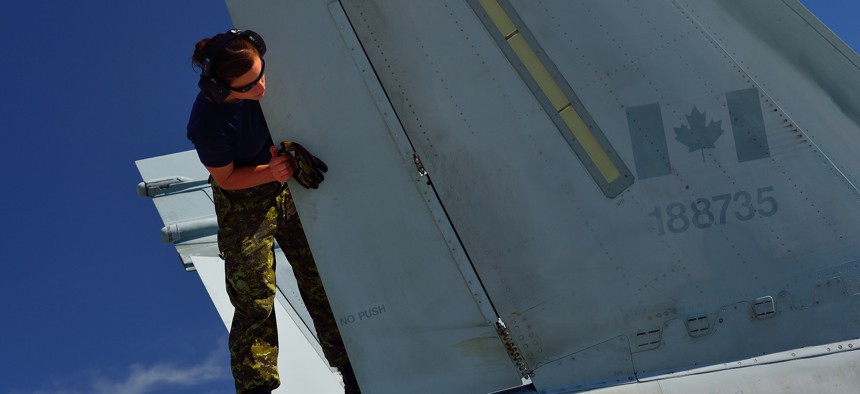
A technician performs post-flight checks on a Royal Canadian Air Force CF-188 Hornet in 2013. Canadian Air Force file photo
What If Canada's New Government Doesn’t Buy the F-35?
The F/A-18 Super Hornet could be the RCAF’s next top fighter if the new Liberal government keeps its vow to jettison the Joint Strike Fighter.
Justin Trudeau, the new Prime Minister, has vowed to “reduce the procurement budget for replacing the CF-18s” — its version of Boeing’s older F/A-18 Hornet — “and will instead purchase one of the many, lower-priced options that better match Canada’s defence needs.”
America’s Boeing, France’s Dassault, and even Sweden’s Saab have all offered cheaper alternatives to the F-35, built by prime contractor Lockheed Martin.
“The [F-35] could face more competition from the F/A-18 and Dassault Rafale, both of which could be in production longer based on international orders,” Byron Callan, an analyst with Capital Alpha Partners, wrote in a note to investors Tuesday. “While neither is comparable to the F-35, both represent good-enough alternatives for some countries.”
The Super Hornet, Rafale and Gripen are considered among the best of the current generation of fighter jets. But compared to the stealthy F-35, they stick out on radar like sore thumbs. If Canada chooses an older jet, it may also be dumping any hope of operating over battlefields protected by sophisticated surface-to-air missiles and long-range radars.
The F-35, like all stealthy aircraft, can carry a few weapons in a bomb bay, and hang more from its wings once enemy air defenses are no longer a concern. In the U.S. military, stealthy B-2 aircraft often deliver the “first strike,” taking out surface-to-air missiles and enemy aircraft, as in Libya. Once those threats are destroyed, non-stealthy aircraft, such as F/A-18s, F-16s and A-10s come in and support ground forces.
The U.S. military has used stealthy F-22 fighters to bomb Islamic State militants in Syria, particularly in the early stages of the campaign when it did not know whether President Bashar al-Assad would fire back at the American warplanes. F-22s and other non-stealthy jets have been striking ISIS targets ever since.
Canada, which is part of the anti-ISIS coalition, has sent its CF-18s to strike targets in Syria. But Trudeau’s party has questioned the need for stealthy attack aircraft if Canada is not flying first-strike missions.
“The primary mission of our fighter aircraft should remain the defence of North America, not stealth first-strike capability,” the Liberal party writes. That mission includes intercepting enemy planes and ships; American and Canadian fighter jets occasionally intercept Russian bombers in international airspace near their coastlines.
Canada has planned to buy 60 F-35s to replace its 30-year-old CF-18 Hornets, but the purchase has been debated for years — memorably stirred by a 2014 video of two boys playing with toy fighter jets. When a boy says he bought an F-35 with the $10 given to him by his grandfather, his brother says he bought three Super Hornets.
Experts say the Super Hornet — cheaper and easily integrated into the Canadian Air Force — is indeed the most likely replacement for the F-35.
“What they really want is something that guarantees air sovereignty, and frankly, the CF-18 has done the job and chances are the Super Hornet will do the job,” said Richard Aboulafia, vice president for analysis at the Teal Group consulting firm.
The CF-18 has been Canada’s only fighter jet since the CF-5 Freedom Fighter retired 20 years ago. Canada has been part of the F-35 project since the 1990s, and officially became a program partner in 2002. Canadian companies supply parts for the F-35.
Had conservatives won Canada’s election, the government would likely have bought four to eight F-35s a year beginning in 2017, Callan wrote. Each would have cost $80 million to $100 million. But if Canada drops out of the international program, the price tag could rise for everyone else. “[A]n issue for the F-35 remains how much further the unit price could be reduced, particularly if planned production rates aren't achieved by 2018-2020,” Callan wrote.
Aboulafia said that if the Trudeau government inks a deal to buy a new aircraft, it is unlikely a new government down the road would void that to buy F-35s. Canada “kept putting off their replacement requirement both for budgetary reasons and because they were waiting for the F-35,” Aboulafia said. “Now that the new government has come in, they have a rationale for a pressing purchase decision, [which means] it’ll happen on their watch and it will stay happened on their watch.”







